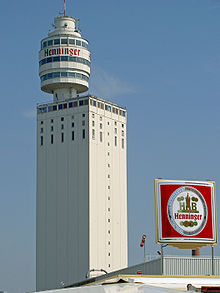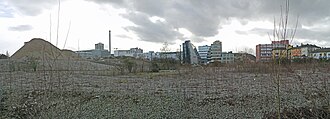Henninger Brewery
Henninger-Bräu was the name of a brewery in the Frankfurt district of Sachsenhausen , which became known nationwide through the bike race around the Henninger Tower .
The brand and distribution rights of the Henninger brand were sold in 2001 to the immediately neighboring Binding brewery ; In 2002 the group holding Binding-Brauerei AG became the Radeberger Group . The Henninger-Brau AG is now a subsidiary of Radeberger group. The real estate of the former Henninger-Bräu AG is owned by Actris AG .
The Henninger Tower , a former grain silo on the edge of the former brewery site, was considered one of Frankfurt's landmarks and was also known to many air travelers from their approach to Frankfurt am Main Airport because of its beer barrel-like restaurant top sitting on the side of a cubic tower . The stylized tower in the trademark - between the letters H and B - shows another Frankfurt landmark, the Eschenheim tower .
Until 2009 the brewer was the main sponsor of the race around the Henninger tower .
history
Establishment of Henninger-Bräu AG
Henninger was founded in 1655 when Eberhard Stein founded a brewery . Heinrich Christian Henninger , who came from Erlangen , joined the Stein brewery in 1873 and ran it together with Johannes Stein, a descendant of the founder. Henninger had previously bought breweries in Erlangen and Nuremberg and sold them again after a certain period of time. From then on, the brewery was called Heinrich Henninger & Sons, Stein Brewery .
As early as 1881, when it was converted into a stock corporation, the name was changed again to Frankfurter Bierbrauerei-Gesellschaft vorm. Heinrich Henninger & Sons .
After the acquisition of several competitors in 1921 and a related change of name ( Brewery Henninger-Kempff-Stern and Joh. Gerhard Henrich AG ), the name was changed to the more memorable Henninger-Bräu AG in 1935 .
1950s to 1990s

In 1951, at the request of American soldiers stationed in Frankfurt am Main, Henninger-Bräu AG was the first brewery in Germany to introduce the beer can. In the same year, the brewery's future flagship brand, the Henninger Kaiser Pilsner, was brought onto the market. Export began in 1953.
In 1958 the city of Frankfurt imposed a ban on driving horse-drawn vehicles into the city center . Up until then, the breweries had supplied their restaurants with carts, which they were now gradually replacing with trucks. Henninger only operated a six-man team until 2000 for representational purposes . It was used at up to 80 events a year, for example the carnival parades in Frankfurt and Heddernheim .
In 1961, when the company's own malt house was expanded, a malt silo was built which, with a revolving restaurant at its top, was almost 120 meters high and for many years the tallest building in the city. As the Henninger Tower , the building first became a symbol for the aspiring company and soon became a symbol of the city. In order to promote public acceptance of the building, which was initially controversial, the cycling race around the Henninger Tower took place for the first time in 1962 , and for many decades it was one of the most important international cycling races in Germany. In the 1960s, Henninger beer was exported to numerous countries or brewed under license, including Greece , Spain and the USA .
In 1970 a majority stake in the Mannheim Eichbaum breweries was acquired. In the 1970s, Henninger was at times the largest single brewery in Germany.
In 1980 Reemtsma took over the majority of the Henninger brewery, in 1987 the group of companies Gebrüder März from Rosenheim. Due to the declining beer consumption in Germany, but also due to wrong entrepreneurial decisions, the Henninger Group, to which supra-regional brands such as Jever belonged at the time , got increasingly into trouble. The popular Kaiser-Pilsner was replaced in 1984 by the Christian Henninger beer , with the aim of meeting a national taste. At the same time, new bottles and beer crates were introduced. The new crates had 16 bottles instead of the previous 20, but were sold for the same price. As a result, beer consumption among regular customers collapsed. Only after years was the step reversed, and the brewery was able to find its way back to its former strength in the short term.
In 1995, Henninger was the first brewery in Germany to introduce the Henninger Radler, a mixed beer drink . The very successful 0.5-liter can had the special feature that it was the first product sold in Germany that was offered with two brand names on one package, Henninger Radler on the one hand and Henninger Alsterwasser on the other. Another new product that was heavily advertised at times in the 1990s was the Highlander , a light smoked beer made from whiskey malt according to the brewery .
After bankruptcy
After the March group went bankrupt in 1996, the Mannheim entrepreneur Dietmar Hopp took over the majority in Henninger in 1999. He renamed the company to Actris , closed the brewery on the old site and sold the trademark rights in 2001 to local rivals Binding, which belongs to the Oetker Group .
Today the Radeberger Group holds the rights to the brand in Germany. For foreign markets, it is partially licensed to other beverage groups, for example for the Greek market to Carlsberg A / S , where the Kaiser-Pilsner from Henninger is a popular beer.
The Henninger area was built with offices and apartments until 2016. The Henninger tower was demolished in summer 2013. The new Henninger Tower , which is similar to the old one, was built in its place .
Web links
Individual evidence
- ↑ Frankfurter Allgemeine Sonntagszeitung, December 29, 1996, No. 52, p. 11
- ↑ Extremely helpful . In: Der Spiegel . No. 41 , 1987 ( online ).
- ^ New construction of the Henninger Tower


